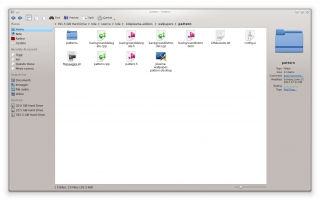Dolphin/it: Difference between revisions
No edit summary |
No edit summary |
||
| Line 36: | Line 36: | ||
== Consigli, suggerimenti e risoluzione dei problemi == | == Consigli, suggerimenti e risoluzione dei problemi == | ||
'''Problema:''' le voci del menu di Dolphin <menuchoice>Visualizza -> Ulteriori informazioni</menuchoice> e/o <menuchoice>Visualizza -> Pannelli</menuchoice> non hanno opzioni. Nepomuk è attivato in Impostazioni di sistema. | |||
: | |||
:'''Solution:''' Rename the folder <tt>~/.kde4/share/apps/dolphin</tt> (in some distros it will be <tt>~/.kde/share/apps/dolphin</tt>) and restart dolphin. This will purge your dolphin customizations but the entries should be back. If everything works as expected you can then delete the folder. This happened to me after an upgrade from KDE 4.4 to 4.5 | |||
'''Problem:''' When I choose the application to open a specific filetype with, it seems to affect other filetypes too. It’s like Dolphin cannot tell the difference between the '''two different filetypes'''. | |||
:'''Solution:''' Probably the KDE platform does not know about one of the two filetypes, so it associates the filetype to a different, known filetype. This is common with XML-based filetypes; even if they use a file extension of their own (e.g. .xliff or .graphml), if they are not a filetype known by the KDE platform, they will be treated as any other XML file, and opened with the default application to open XML files. | |||
:To solve this issue, you can use '''[[Special:myLanguage/System Settings/File Associations|File Associations]]''' to [[Special:myLanguage/System Settings/File Associations#Adding new file types|create an entry for the unrecognized filetype]]. | |||
Puoi anche visitare il [http://dolphin.kde.org sito di Dolphin] | Puoi anche visitare il [http://dolphin.kde.org sito di Dolphin] | ||
Revision as of 10:21, 18 November 2012
 |
Il gestore di file focalizzato sull'usabilità |
Panoramica delle caratteristiche
- Gestore di file specializzato e semplice da utilizzare;
- grande attenzione all'usabilità;
- barra di navigazione breadcrumb;
- pannelli opzionali per una comoda navigazione e per visualizzare le informazioni;
- supporto alla gestione remota dei file e a pseudo-filesystem tramite KIO;
- possibilità di etichettare file e cartelle e di trovare i file sulla base del contenuto utilizzando Nepomuk.
A prima vista è un semplice gestore di file, ma ha molte possibilità. Alcune caratteristiche sono:
- Divisione dell'area di lavoro, per visualizzare e utilizzare due cartelle allo stesso tempo
- Modalità di visualizzazione definibile (e memorizzabile) indipendentemente per ogni cartella
- Navigazione a schede
- Possibilità di utilizzare un pannello informazioni
- O scegliere di visualizzare direttamente nell'area di lavoro le informazioni essenziali dei file e delle cartelle
- Utilizzo della navigazione 'breadcrumb' per velocizzare l'accesso alle cartelle
- Possibilità di passare con un click dalla barra di navigazione alla tradizionale barra degli indirizzi
- Disponibilità di un pannello Cartelle per visualizzare la tradizionale struttura ad albero delle cartelle
- Possibilità di aprire un pannello Terminale sulla cartella in uso
- Molte funzioni sono gestibili anche tramite scorciatoie da tastiera
Guide
Consigli, suggerimenti e risoluzione dei problemi
Problema: le voci del menu di Dolphin e/o non hanno opzioni. Nepomuk è attivato in Impostazioni di sistema.
- Solution: Rename the folder ~/.kde4/share/apps/dolphin (in some distros it will be ~/.kde/share/apps/dolphin) and restart dolphin. This will purge your dolphin customizations but the entries should be back. If everything works as expected you can then delete the folder. This happened to me after an upgrade from KDE 4.4 to 4.5
Problem: When I choose the application to open a specific filetype with, it seems to affect other filetypes too. It’s like Dolphin cannot tell the difference between the two different filetypes.
- Solution: Probably the KDE platform does not know about one of the two filetypes, so it associates the filetype to a different, known filetype. This is common with XML-based filetypes; even if they use a file extension of their own (e.g. .xliff or .graphml), if they are not a filetype known by the KDE platform, they will be treated as any other XML file, and opened with the default application to open XML files.
- To solve this issue, you can use File Associations to create an entry for the unrecognized filetype.
Puoi anche visitare il sito di Dolphin e consultare il manuale.
Parole chiave
Gestione dei file, gestore dei file, file manager, file browser, tag, etichette, metadata, Nepomuk
